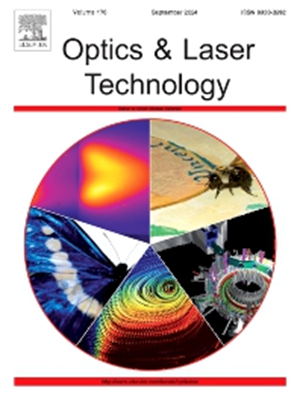Dimensionality reduction calibration of a robotic grinding head’s 3D coordinate system using a 1D laser sensor
IF 4.6
2区 物理与天体物理
Q1 OPTICS
引用次数: 0
Abstract
The demand for highly accessible grinding in confined spaces, such as integral blisks, has driven research and applications in robotic grinding and polishing using a grinding head. Achieving high-precision and low-cost calibration of the grinding head is a primary challenge. Consequently, a novel dimensionality reduction calibration method is proposed. This method employs a 1D point laser displacement sensor to calibrate the 3D grinding head coordinate system. Firstly, a hand-eye calibration method for the sensor is proposed. The “fitting and one-step rotation method” determines the rotation axis and angle through the fitting, followed by one-step rotation to make the flange plane parallel to the laser emission plane, thereby completing the sensor orientation calibration. The “two-step rotation method” aligns the flange center with the measurement origin of the sensor to complete the sensor position calibration. Subsequently, the 3D grinding head coordinate system is calibrated with the pre-calibrated sensor as an intermediary. The “two-step translation method” makes the grinding head’s end face parallel to the laser emission plane, completing the grinding head’s orientation calibration. The “spatial three-point method” aligns the grinding head center with the sensor’s measurement origin, completing the grinding head’s position calibration. Finally, the experiments demonstrate that the precision of hand-eye calibration can be maintained within 0.178 mm and 0.6°, while the accuracy of the grinding head calibration is within 0.08 mm and 0.4°. The calibration method provides high precision, low cost, and reliable stability while supporting programming for rapid calibration, thereby facilitating the high-precision automation of robotic grinding and polishing.
求助全文
约1分钟内获得全文
求助全文
来源期刊
CiteScore
8.50
自引率
10.00%
发文量
1060
审稿时长
3.4 months
期刊介绍:
Optics & Laser Technology aims to provide a vehicle for the publication of a broad range of high quality research and review papers in those fields of scientific and engineering research appertaining to the development and application of the technology of optics and lasers. Papers describing original work in these areas are submitted to rigorous refereeing prior to acceptance for publication.
The scope of Optics & Laser Technology encompasses, but is not restricted to, the following areas:
•development in all types of lasers
•developments in optoelectronic devices and photonics
•developments in new photonics and optical concepts
•developments in conventional optics, optical instruments and components
•techniques of optical metrology, including interferometry and optical fibre sensors
•LIDAR and other non-contact optical measurement techniques, including optical methods in heat and fluid flow
•applications of lasers to materials processing, optical NDT display (including holography) and optical communication
•research and development in the field of laser safety including studies of hazards resulting from the applications of lasers (laser safety, hazards of laser fume)
•developments in optical computing and optical information processing
•developments in new optical materials
•developments in new optical characterization methods and techniques
•developments in quantum optics
•developments in light assisted micro and nanofabrication methods and techniques
•developments in nanophotonics and biophotonics
•developments in imaging processing and systems

 求助内容:
求助内容: 应助结果提醒方式:
应助结果提醒方式:


